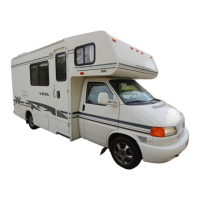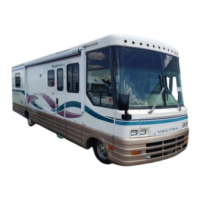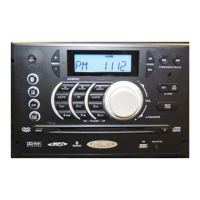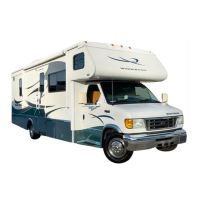Do you have a question about the Winnebago VIEW 24D and is the answer not in the manual?
Explains the purpose and scope of the operator's manual and its contents.
Defines safety alert terms (DANGER, WARNING, CAUTION, NOTICE) used throughout the manual.
Details the dealer's responsibility for pre-delivery inspection of the motorhome before shipment.
Advises familiarizing with local regulations before traveling.
Recommends checking and adjusting front suspension and steering alignment after loading.
Provides information on obtaining dealer assistance and warranty repairs while traveling.
Instructs on reporting potential safety defects to NHTSA and Winnebago Industries.
Explains the label showing vehicle occupant and cargo carrying capacity.
Describes the vehicle certification label, its location, and the information it contains.
Presents detailed specifications and capacities for different motorhome models.
Provides fields for recording owner and vehicle details for reference.
Covers general warnings, driving safety, and essential checks before operating the vehicle.
Details critical safety warnings and procedures for fuel and propane gas systems, including leak detection.
Explains the function and testing of Carbon Monoxide and Smoke Alarms for safety.
Locates and describes the fire extinguisher and its maintenance.
Outlines crucial safety precautions for handling electrical components and systems.
Advises on securing items, distributing cargo, and managing vehicle load capacity.
Explains how to operate emergency exits and provides guidance for roadside emergencies like flat tires.
Covers procedures for wheel mounting nuts, trim, and stylized wheel care.
Provides instructions for jump starting the engine and handling engine overheating.
Details adjustment, fastening, and care of driver/co-pilot and passenger seat belts.
Provides guidelines for selecting, installing, and using child restraint systems safely.
Explains the types of keys provided and the operation of the remote keyless entry system.
Describes the function of hazard warning flashers for safety when stopped on the roadway.
Explains the features and function of the collision avoidance system.
Covers the radio, rearview monitor, and infotainment center/GPS features.
Details the operation of the infotainment center, including radio, GPS, Bluetooth, and USB.
Explains the use of the battery boost switch for emergency engine starting.
Provides guidance on checking and maintaining the engine cooling system and DEF fill.
Recommends checking exterior lights and provides instructions for valve stem access.
Discusses tire pressure, wear, and the importance of suspension alignment for handling.
Explains how to operate the refrigerator and the propane gas range top burners.
Warns about dangers of asphyxiation from cooking appliances and recommends ventilation.
Describes the monitor panel and the roof-mounted solar charge panel for system status and battery charging.
Details operation of gas/electric and tankless water heaters, including P-T valve.
Provides instructions for furnace operation and explains the heat pump and air conditioning systems.
Explains the propane gas system, its components, and safe handling precautions.
Details the procedure for refilling the propane tank at a dealership.
Outlines essential safety precautions and guidelines for using the propane system.
Explains the function and maintenance of the propane gas pressure regulator.
Discusses how cold weather affects propane vaporization and potential solutions.
Provides general safety precautions for electrical components and overviews the 12V/120V systems.
Details how to connect the external power cord to an external power source safely.
Explains the function of the 1000W inverter and its wall-mounted control panel.
Describes the converter's function and how it charges house batteries from external power.
Explains the function of circuit breakers and GFCI outlets for electrical protection.
Provides basic operating instructions for LP and Diesel generators.
Outlines the DC voltage systems, including house batteries and chassis battery.
Details the house/coach battery disconnect switch, access, and battery care practices.
Explains the function of 12V DC circuit breakers and fuses for coach systems.
Explains the fresh water system, filling methods, and water pressure regulators.
Explains the water pump's function, priming, and strainer cleaning.
Describes the cold water filter and procedures for disinfecting the fresh water system.
Covers toilet operation, important "don'ts", and electric flush toilet features.
Explains the drainage system, holding tanks, and procedures for dumping them.
Details water heater bypass, antifreeze valves, and winterizing the water system.
Explains basic operation of the audio/video system, DVD player, and sound routing.
Covers connecting exterior speakers and setting up TV video input.
Explains operation of the digital TV antenna and satellite/cable TV connection points.
Describes cab seat lounge cushion use and safety warnings for sleeping facilities.
Explains front bunk conversion, bunk ladder use, and dinette to bed conversion.
Details dining table setup/storage and sofa/sleeper conversion to a bed.
Explains sectional dinette conversion and the operation of the Murphy bed.
Describes Flex Bed system, adjustable headrests, and roller shades.
Provides care instructions for wood furniture and cabinetry, including wood types.
Explains the ignition key and park brake requirements for slideout operation.
Details the operation of electric slideout rooms and recommends running the engine.
Provides critical safety warnings and precautions for extending and retracting slideout rooms.
Offers guidance on troubleshooting slideout room issues, including battery and circuit breaker checks.
Provides tips for cleaning slideout room seals and floors before operation.
Emphasizes regular inspection of sealants, roof safety, and undercarriage cleaning.
Provides precautions for exterior paint finish, plastics, and exterior lights.
Details care for upholstery, cabinetry, countertops, sinks, and vinyl flooring.
Provides a checklist for preparing the coach for storage and steps for removal after storage.
Presents a recommended maintenance schedule for various coach systems and components.
Explains loading, cargo distribution, weighing, and understanding weight ratings.
Provides guidelines for towing vehicles/trailers, hitch ratings, and trailer wiring connections.
Details operation of stabilizing jacks and electric entry steps.
Explains operation of windows, skylight vent, and power roof ventilator.
Covers storage door latching, roof ladder safety, awning operation, and bike rack use.
Provides steps to reduce excessive moisture and condensation inside the motorhome.
Explains the purpose and scope of the operator's manual and its contents.
Defines safety alert terms (DANGER, WARNING, CAUTION, NOTICE) used throughout the manual.
Details the dealer's responsibility for pre-delivery inspection of the motorhome before shipment.
Advises familiarizing with local regulations before traveling.
Recommends checking and adjusting front suspension and steering alignment after loading.
Provides information on obtaining dealer assistance and warranty repairs while traveling.
Instructs on reporting potential safety defects to NHTSA and Winnebago Industries.
Explains the label showing vehicle occupant and cargo carrying capacity.
Describes the vehicle certification label, its location, and the information it contains.
Presents detailed specifications and capacities for different motorhome models.
Provides fields for recording owner and vehicle details for reference.
Covers general warnings, driving safety, and essential checks before operating the vehicle.
Details critical safety warnings and procedures for fuel and propane gas systems, including leak detection.
Explains the function and testing of Carbon Monoxide and Smoke Alarms for safety.
Locates and describes the fire extinguisher and its maintenance.
Outlines crucial safety precautions for handling electrical components and systems.
Advises on securing items, distributing cargo, and managing vehicle load capacity.
Explains how to operate emergency exits and provides guidance for roadside emergencies like flat tires.
Covers procedures for wheel mounting nuts, trim, and stylized wheel care.
Provides instructions for jump starting the engine and handling engine overheating.
Details adjustment, fastening, and care of driver/co-pilot and passenger seat belts.
Provides guidelines for selecting, installing, and using child restraint systems safely.
Explains the types of keys provided and the operation of the remote keyless entry system.
Describes the function of hazard warning flashers for safety when stopped on the roadway.
Explains the features and function of the collision avoidance system.
Covers the radio, rearview monitor, and infotainment center/GPS features.
Details the operation of the infotainment center, including radio, GPS, Bluetooth, and USB.
Explains the use of the battery boost switch for emergency engine starting.
Provides guidance on checking and maintaining the engine cooling system and DEF fill.
Recommends checking exterior lights and provides instructions for valve stem access.
Discusses tire pressure, wear, and the importance of suspension alignment for handling.
Explains how to operate the refrigerator and the propane gas range top burners.
Warns about dangers of asphyxiation from cooking appliances and recommends ventilation.
Describes the monitor panel and the roof-mounted solar charge panel for system status and battery charging.
Details operation of gas/electric and tankless water heaters, including P-T valve.
Provides instructions for furnace operation and explains the heat pump and air conditioning systems.
Explains the propane gas system, its components, and safe handling precautions.
Details the procedure for refilling the propane tank at a dealership.
Outlines essential safety precautions and guidelines for using the propane system.
Explains the function and maintenance of the propane gas pressure regulator.
Discusses how cold weather affects propane vaporization and potential solutions.
Provides general safety precautions for electrical components and overviews the 12V/120V systems.
Details how to connect the external power cord to an external power source safely.
Explains the function of the 1000W inverter and its wall-mounted control panel.
Describes the converter's function and how it charges house batteries from external power.
Explains the function of circuit breakers and GFCI outlets for electrical protection.
Provides basic operating instructions for LP and Diesel generators.
Outlines the DC voltage systems, including house batteries and chassis battery.
Details the house/coach battery disconnect switch, access, and battery care practices.
Explains the function of 12V DC circuit breakers and fuses for coach systems.
Explains the fresh water system, filling methods, and water pressure regulators.
Explains the water pump's function, priming, and strainer cleaning.
Describes the cold water filter and procedures for disinfecting the fresh water system.
Covers toilet operation, important "don'ts", and electric flush toilet features.
Explains the drainage system, holding tanks, and procedures for dumping them.
Details water heater bypass, antifreeze valves, and winterizing the water system.
Explains basic operation of the audio/video system, DVD player, and sound routing.
Covers connecting exterior speakers and setting up TV video input.
Explains operation of the digital TV antenna and satellite/cable TV connection points.
Describes cab seat lounge cushion use and safety warnings for sleeping facilities.
Explains front bunk conversion, bunk ladder use, and dinette to bed conversion.
Details dining table setup/storage and sofa/sleeper conversion to a bed.
Explains sectional dinette conversion and the operation of the Murphy bed.
Describes Flex Bed system, adjustable headrests, and roller shades.
Provides care instructions for wood furniture and cabinetry, including wood types.
Explains the ignition key and park brake requirements for slideout operation.
Details the operation of electric slideout rooms and recommends running the engine.
Provides critical safety warnings and precautions for extending and retracting slideout rooms.
Offers guidance on troubleshooting slideout room issues, including battery and circuit breaker checks.
Provides tips for cleaning slideout room seals and floors before operation.
Emphasizes regular inspection of sealants, roof safety, and undercarriage cleaning.
Provides precautions for exterior paint finish, plastics, and exterior lights.
Details care for upholstery, cabinetry, countertops, sinks, and vinyl flooring.
Provides a checklist for preparing the coach for storage and steps for removal after storage.
Presents a recommended maintenance schedule for various coach systems and components.
Explains loading, cargo distribution, weighing, and understanding weight ratings.
Provides guidelines for towing vehicles/trailers, hitch ratings, and trailer wiring connections.
Details operation of stabilizing jacks and electric entry steps.
Explains operation of windows, skylight vent, and power roof ventilator.
Covers storage door latching, roof ladder safety, awning operation, and bike rack use.
Provides steps to reduce excessive moisture and condensation inside the motorhome.
| Width | 7'6" |
|---|---|
| Interior Height | 6'8" |
| GVWR | 11, 030 lbs |
| Fuel Type | Diesel |
| Sleeping Capacity | 4 |
| Make | Winnebago |
| Model | VIEW 24D |
| Chassis | Mercedes-Benz Sprinter |
| Horsepower | 188 hp |
| Torque | 325 lb-ft |
| Wheelbase | 170" |
| Exterior Width | 7'6" |
| Transmission | 7-speed automatic |
| Engine | 3.0L V6 Turbo Diesel |
| Grey Water Capacity | 41 gallons |
| Black Water Capacity | 41 gallons |
| GCWR | 15, 250 lbs |
| Fuel Capacity | 24.5 gallons |











